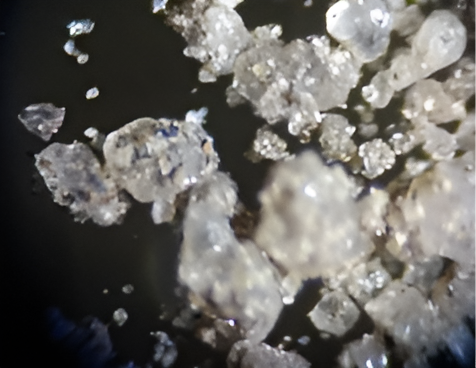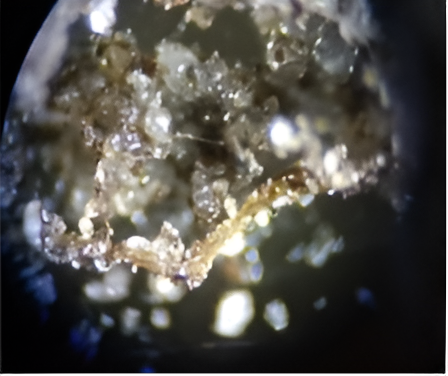Bio-Booster, plus a 50-50 mix of humic acid and sea minerals, was applied to soybeans to test for any effects on yield and soil in two paddocks. The Bio-Booster is an extremely high concentration of living soil biology based on a wide range of locally-sourced soil biology and was ‘grown’ on farm. (See our guides to growing your own BioBooster in Soil Biology category.) The mixture was injected as an inoculant to boost the growth of soil biology. The only extra costs are minor inputs into growing it and one pass-over with a tractor.
The soybean yields in the treated areas averaged 9% higher than those in the controls. This equated to an estimated $190 increase in Gross Margin/ha. Effects of better drainage and increase in soil biology were recorded in photographs. Observations indicated a slow spreading of the soil biology into the nearby rows of the untreated area.
Trial Details
The paddocks had grown sugar cane for the previous four years, and soybeans are used as a break-crop. The farm uses trash blanket, minimum till and controlled traffic practices, all part of regenerative agriculture. Controlled-traffic farming uses computers and satellites to steer machinery on designated tracks to minimise compaction.

The Bio-Booster mix was applied pre-planting, on 6 November 2020 on one paddock and on 23 December 2020 on the second paddock. Soybeans were planted on 12 January 2021 following normal practices and rates. The variety was Kuranda. The area had been fertilised with 150 kg/ha GF402 (7N:6P:32K:2S).
Application of Bio-Booster plus humic acid and sea-minerals required one pass-over by a tractor with coulters and equipped with a 1,000-litre pod to hold the mixture. The mixture was applied at low pressure (less than 60psi otherwise the biology may be killed) through pipes behind the coulters into the soil at about 10 cm deep.
Observations
The Bio-Booster mixture was applied to the rows 2 metres apart, where cane had been and would again be grown. These rows were initially easy to pick out due to better growth. After 60 days the rows either side had almost caught up in growth, and after 100 days the next rows started to improve.
Soil biology does not respect our boundaries and spreads when it can.
Following an irrigation of 45 mm of water on 17th February and rainfall, a visual inspection of possible effects of the soil biology was made six hours after the irrigation on 18th February.

8 holes 30 cm deep showed water present

8 holes 30 cm deep showed NO water present
As shown above, 6 hours after irrigation, there is free water (light patch) in the photo on the left and none in the photo on the right.
Water present indicates poor soil drainage. Roots require water and oxygen to live and be active. Seeing water in the soil like the Control indicates lack of oxygen. If water logging is short term, say a few hours, it will restrict root function but cause little or no permanent damage. If it is days or weeks, it will kill roots. Lack of oxygen encourages the spread of root diseases like Phytophthora.
A second inspection was made the next day on the 19th of February, 105 days after the first application of Bio-Booster. Both times, 8 holes were dug in the control and 8 in the treated areas.

Top 30 cm with good air

As shown above after 30 hours after irrigation, once free water has drained, it leaves behind soil with good air that does not stick to the shovel.
Soil-free areas on the shovels in the photos on the left and right above, the bits between the white lines show the depth of soil that is well drained. They show an increase in depth of well-drained soil from 10 to 30 cm. The soil below the 10 cm in left photo is still saturated, tight and too wet. Not shown in the right photo is the crumbly, aerated structure for more than 30 cm. There were signs of very fine crumbles showing that the biology was active. (Too fine to be visible on these photos.)

Left treated – Right control


The leftmost photo taken on 26 April shows samples of weeds with significant soil adhering to roots. This adherence of soil to roots is a good indicator of biological activity in the rhizosphere.
Soil from the treated and control areas was then photographed under a microscope. The middle photo shows grains of sand from the control soil with very clean sand particles. The rightmost shows grains from the treated soil with dark stains and less light being reflected, indicating the presence of humic compounds. The increased soil adhesion to roots and production of humic compounds on the sand grains indicate an increase in soil biological activity and organic carbon.
Yield and Increase in Gross Margin/ha
Yield samples were taken on the 21st of May, 150 days after application of the Bio-Booster. Treated and control were hand-sampled with 8 replications, each 2m of bed, with 2 rows per bed. Samples from treated areas showed a 9.1% yield gain over those from untreated areas.
A 9% increase on 3.5 t/ha yield equates to 0.32 tonnes soybeans. At $750/t this equates to an increase in income of $240/ha. The cost of Bio-Booster mixture was $20/ha and that of application about $30/ha, giving an increase in Gross Margin of $190/ha.
Under good management, the Bio-Booster will not need to be re-introduced in following years.


